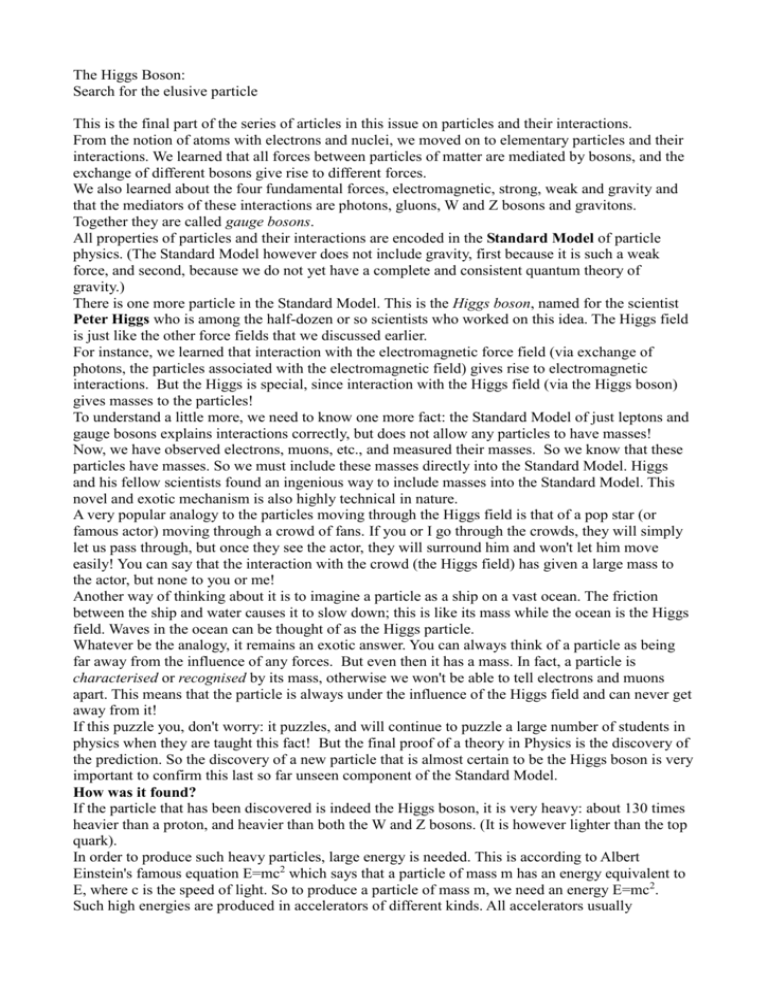5higgs
advertisement

The Higgs Boson: Search for the elusive particle This is the final part of the series of articles in this issue on particles and their interactions. From the notion of atoms with electrons and nuclei, we moved on to elementary particles and their interactions. We learned that all forces between particles of matter are mediated by bosons, and the exchange of different bosons give rise to different forces. We also learned about the four fundamental forces, electromagnetic, strong, weak and gravity and that the mediators of these interactions are photons, gluons, W and Z bosons and gravitons. Together they are called gauge bosons. All properties of particles and their interactions are encoded in the Standard Model of particle physics. (The Standard Model however does not include gravity, first because it is such a weak force, and second, because we do not yet have a complete and consistent quantum theory of gravity.) There is one more particle in the Standard Model. This is the Higgs boson, named for the scientist Peter Higgs who is among the half-dozen or so scientists who worked on this idea. The Higgs field is just like the other force fields that we discussed earlier. For instance, we learned that interaction with the electromagnetic force field (via exchange of photons, the particles associated with the electromagnetic field) gives rise to electromagnetic interactions. But the Higgs is special, since interaction with the Higgs field (via the Higgs boson) gives masses to the particles! To understand a little more, we need to know one more fact: the Standard Model of just leptons and gauge bosons explains interactions correctly, but does not allow any particles to have masses! Now, we have observed electrons, muons, etc., and measured their masses. So we know that these particles have masses. So we must include these masses directly into the Standard Model. Higgs and his fellow scientists found an ingenious way to include masses into the Standard Model. This novel and exotic mechanism is also highly technical in nature. A very popular analogy to the particles moving through the Higgs field is that of a pop star (or famous actor) moving through a crowd of fans. If you or I go through the crowds, they will simply let us pass through, but once they see the actor, they will surround him and won't let him move easily! You can say that the interaction with the crowd (the Higgs field) has given a large mass to the actor, but none to you or me! Another way of thinking about it is to imagine a particle as a ship on a vast ocean. The friction between the ship and water causes it to slow down; this is like its mass while the ocean is the Higgs field. Waves in the ocean can be thought of as the Higgs particle. Whatever be the analogy, it remains an exotic answer. You can always think of a particle as being far away from the influence of any forces. But even then it has a mass. In fact, a particle is characterised or recognised by its mass, otherwise we won't be able to tell electrons and muons apart. This means that the particle is always under the influence of the Higgs field and can never get away from it! If this puzzle you, don't worry: it puzzles, and will continue to puzzle a large number of students in physics when they are taught this fact! But the final proof of a theory in Physics is the discovery of the prediction. So the discovery of a new particle that is almost certain to be the Higgs boson is very important to confirm this last so far unseen component of the Standard Model. How was it found? If the particle that has been discovered is indeed the Higgs boson, it is very heavy: about 130 times heavier than a proton, and heavier than both the W and Z bosons. (It is however lighter than the top quark). In order to produce such heavy particles, large energy is needed. This is according to Albert Einstein's famous equation E=mc2 which says that a particle of mass m has an energy equivalent to E, where c is the speed of light. So to produce a particle of mass m, we need an energy E=mc2. Such high energies are produced in accelerators of different kinds. All accelerators usually accelerate charged particles either by electric or magnetic fields (or a combination). For example, the Z boson was studied by producing it in collisions of high energy electrons and anti-electrons. At the Large Hadron Collider LHC, two protons with energies about 4000 times the mass-equivalent energy of a proton, circulate in a large underground pipe about 27 km in circumference. The accelerator is built so that these protons can collide in four different places; at these points, sensitive detectors are placed in order to observe what happens in the collisions. In the interactions that took place, Higgs bosons were sometimes produced. Since the Higgs particle is so massive, it immediately decays (breaks up) into lighter particles, but with a characteristic signature. For instance, it can decay into two photons or two Z bosons. But there are many other particles that can be produced in such a high energy collision that can also produce two photons/Zs. The hard part is to sort out the known events (called background). Any excess remaining is then due to the Higss particle. Physicists at two detectors called CMS and ATLAS searched for these signals and found evidence of a particle of mass about 133 times the mass of a proton. A similar but not as convincing find was also made by the CDF and D0 experiments at the Fermilab collider in the U.S.A. which collides protons on anti-protons. That this is indeed the Higgs boson needs several more tests, which will be made over the rest of this year. Pictures show the layout of the massive ATLAS and CMS detectors (look for the little man at the bottom of each picture that indicates the scale of the detectors). Since thousands of particles are produced in each collision, the detector needs to be designed to be sensitive to all possible types of particles like electrons, muons, etc. In fact, both these detectors were built in sections all over the world and then carefully assembled underground. Also shown are samples of how the collisions look in each detector. The lines indicate the tracks of various particles that were produced at the collision vertex. Extremely complex computer algorithms are used to disentangle the various tracks and recognise the myriad particles. Particle physics and technology The experiments at the LHC and other similar colliders may tell us what the Universe is made of, thus continuing to address the question that mankind has been asking since the beginning. But these questions are now being answered with increasingly sophisticated technology. Intense research into engineering, computer software and hardware was needed to allow this progress to happen. Detectors sensitive to various high energy elementary particles have found application in medical imaging such as PET and CT scans. The world-wide-web (WWW) was created in CERN to handle transfer of enormous amounts of data created during each collision. Today this powers the Internet which has reached the common man. While the discovery of the Higgs particle itself may not change our existence, or the quality of our lives, the tools that scientists have discovered on the way are sure to transform our lives in the future. What next? Scientists need to confirm that this is indeed the Higgs boson. For instance, they must check that it has the predicted spin of zero. However, this is not all. Remember that interactions of a particle with the Higgs field give it mass. What gives the Higgs boson itself mass?! It turns out that self-interactions of the Higgs field do this, but there is a problem. The Higgs mass comes out to be arbitrarily large which means you can set it to as large a number as you can think of. This is one pointer to the fact that the Standard Model, while now being verified in all its aspects, is actually incomplete. This indicates that there may be a new theory that will show why the Higgs mass is a stable and finite value, perhaps also why there are three copies (or generations) of leptons and quarks. In addition, the Standard Model assumed that neutrinos were massless, but now we have evidence to the contrary. Since neutrinos experience purely weak interactions, they are a wonderful probe for these forces. But the fact that they have non-zero masses and also some other very exotic properties also indicates that we need to extend the Standard Model of particle physics. In the meanwhile, scientists have also been tackling the last bastion: gravity. While theorists are working hard on a unified theory of gravity experimentalists have been studying the skies to learn more about our Universe. They have made some exciting findings: different parts of our Universe, which is believed to have begun in an enormous Big Bang nearly 14 billion years ago, are accelerating away from each other. This is because about 70% of our Universe is filled with an unknown dark energy, the nature of which is not understood. Even among the more familiar galaxies in our Universe, not all is known: only about 4% of our Universe is made of ordinary matter (quarks and leptons). About 23% of our Universe is made up of some unknown kind of matter called dark matter (because it is not luminous and does not shine in ordinary light). What can this dark matter be? Some of the theories that extend the Standard Model also predict the existence of extra particles; perhaps one or more of these may constitute dark matter. So the discovery of the Higgs boson, while completing one chapter in the history of particle physics, is poised to start new ones. Whatever be the final end of the story, it is fascinating. After all it is the story of the only Universe that we have ever known.






